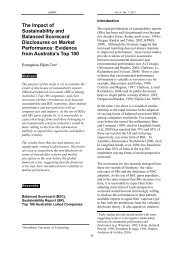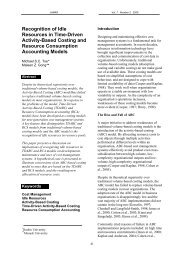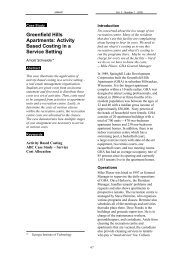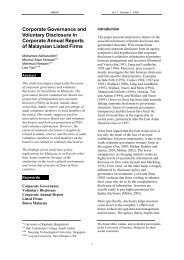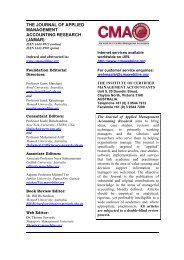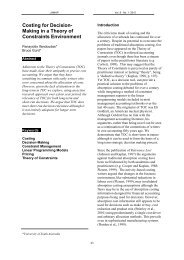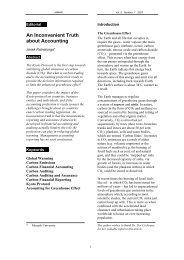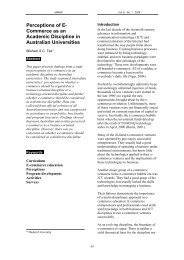Investigating the Determinants of Perceived Procedural Fairness in ...
Investigating the Determinants of Perceived Procedural Fairness in ...
Investigating the Determinants of Perceived Procedural Fairness in ...
- No tags were found...
You also want an ePaper? Increase the reach of your titles
YUMPU automatically turns print PDFs into web optimized ePapers that Google loves.
JAMAR Vol. 11 · No. 1 2013subord<strong>in</strong>ates’ perception <strong>of</strong> fairness <strong>of</strong>performance evaluation processes. In do<strong>in</strong>g so,he constructed three categories <strong>of</strong> performanceevaluation style: Budget Constra<strong>in</strong>ed (BC)style (budgetary <strong>in</strong>formation is used <strong>in</strong> a rigidmanner), Pr<strong>of</strong>it Conscious (PC) style(budgetary <strong>in</strong>formation is used <strong>in</strong> a moreflexible manner, and Non-account<strong>in</strong>g (NA)style (budgetary <strong>in</strong>formation is seen as be<strong>in</strong>g<strong>of</strong> secondary importance). His results<strong>in</strong>dicated that BC style is perceived as less fairthan <strong>the</strong> o<strong>the</strong>r styles. Otley (1978) replicatedHopwood’s (1972) study and found, contraryto Hopwood’s study, that supervisoryevaluative style is not significantly associatedwith perception <strong>of</strong> fairness <strong>of</strong> performanceevaluation processes.Lau and Moser (2008) exam<strong>in</strong>ed <strong>the</strong> effect <strong>of</strong>nonf<strong>in</strong>ancial performance measures onsubord<strong>in</strong>ates’ perception <strong>of</strong> proceduralfairness, argu<strong>in</strong>g that <strong>the</strong>ir use may lead tohigher perceptions <strong>of</strong> fairness <strong>in</strong> performanceevaluation processes (procedural fairness).They also argue that nonf<strong>in</strong>ancial measures aremore consistent with <strong>the</strong> procedural fairnessrules/criteria proposed by Leventhal (1980).Their f<strong>in</strong>d<strong>in</strong>gs show a positive associationbetween nonf<strong>in</strong>ancial measure usage andprocedural fairness.Lau and Sholih<strong>in</strong> (2005) contended and foundthat both nonf<strong>in</strong>ancial and f<strong>in</strong>ancial measuresare positively associated with proceduralfairness, although <strong>the</strong> effect <strong>of</strong> f<strong>in</strong>ancialmeasures on fairness was higher compared tothat <strong>of</strong> nonf<strong>in</strong>ancial measures. This is <strong>in</strong>contrast with Hopwood’s (1972) f<strong>in</strong>d<strong>in</strong>g that<strong>the</strong> effect <strong>of</strong> Non-Account<strong>in</strong>g style on fairnessis significantly higher than that <strong>of</strong> <strong>the</strong> Budget-Constra<strong>in</strong>ed style.A more recent study by Hartman et al. (2009)argues that <strong>the</strong> use <strong>of</strong> subjective performancemeasures is positively associated withprocedural fairness. However, <strong>the</strong>ir f<strong>in</strong>d<strong>in</strong>gsdo not support this argument. Indeed,procedural fairness is associated with <strong>the</strong> use<strong>of</strong> objective performance measures.Hartmann and Slapnicar (2009) argue thatprocedural fairness is not affected byperformance measures or metrics used toevaluate subord<strong>in</strong>ates’ performance but isaffected by <strong>the</strong> degree <strong>of</strong> formality <strong>in</strong> <strong>the</strong> use<strong>of</strong> <strong>the</strong> performance evaluation system. Theirempirical f<strong>in</strong>d<strong>in</strong>gs, however, show nosignificant association between formality andprocedural fairness.The forego<strong>in</strong>g summary <strong>of</strong> relevant priorstudies present a confus<strong>in</strong>g, evencontradictory, picture <strong>of</strong> <strong>the</strong> antecedents <strong>of</strong>procedural fairness <strong>in</strong> PMERS. Given <strong>the</strong>importance <strong>of</strong> this variable, as identifiedearlier by Anthony and Gov<strong>in</strong>darajan (1998)and Kaplan and Atk<strong>in</strong>son (1998), <strong>the</strong> desire toclarify and better understand <strong>the</strong> determ<strong>in</strong>ants<strong>of</strong> perceived procedural fairness providesstrong motivation for this study. In this paper,we <strong>in</strong>vestigate <strong>the</strong> determ<strong>in</strong>ants, orantecedents, <strong>of</strong> procedural fairness perception<strong>in</strong> performance measurement, evaluation andreward systems.This study is different from previous studies,particularly Sholih<strong>in</strong> and Pike (2009), <strong>in</strong> <strong>the</strong>follow<strong>in</strong>g ways. First, whilst Sholih<strong>in</strong> and Pike(2009) <strong>in</strong>vestigates <strong>the</strong> consequences <strong>of</strong>procedural fairness, this study <strong>in</strong>vestigates <strong>the</strong>determ<strong>in</strong>ants <strong>of</strong> procedural fairness. Second,<strong>the</strong> variables exam<strong>in</strong>ed by Sholih<strong>in</strong> and Pike(2009) are procedural fairness, distributivefairness, trust, organisational commitment, jobsatisfaction, and managerial performance. Thevariables exam<strong>in</strong>ed <strong>in</strong> this study areprocedural fairness, participation <strong>in</strong> targetsett<strong>in</strong>g, transparency <strong>of</strong> <strong>the</strong> goal-atta<strong>in</strong>mentrewardl<strong>in</strong>k, goal specificity, f<strong>in</strong>ancialmeasures, and nonf<strong>in</strong>ancial measures. Third,whilst Sholih<strong>in</strong> and Pike (2009) employsorganisational justice <strong>the</strong>ory, <strong>in</strong> this study weuse organisational justice and goal-sett<strong>in</strong>g<strong>the</strong>ories.Draw<strong>in</strong>g on organisational justice literature(e.g. L<strong>in</strong>d and Tyler, 1988; Leventhal, 1980)and goal-sett<strong>in</strong>g <strong>the</strong>ory (Locke and Latham,1990), this study argues that a manager’sperception <strong>of</strong> procedural fairness is <strong>in</strong>fluencedby goal-related variables <strong>in</strong> <strong>the</strong> form <strong>of</strong>participation <strong>in</strong> sett<strong>in</strong>g performance targets,<strong>the</strong> goal-atta<strong>in</strong>ment-reward l<strong>in</strong>k, and <strong>the</strong>specificity <strong>of</strong> goals to be achieved bymanagers; but is not affected by <strong>the</strong> form <strong>of</strong>performance measures used to evaluateperformance, whe<strong>the</strong>r f<strong>in</strong>ancial (objective) ornonf<strong>in</strong>ancial (subjective) measures, as arguedby Lau and Sholih<strong>in</strong> (2005), Lau and Moser(2008), and Hartmann et al., (2009).The proposition that procedural fairness isdeterm<strong>in</strong>ed by <strong>the</strong> degree <strong>of</strong> participation <strong>in</strong>target sett<strong>in</strong>g draws on <strong>the</strong> literature on30




